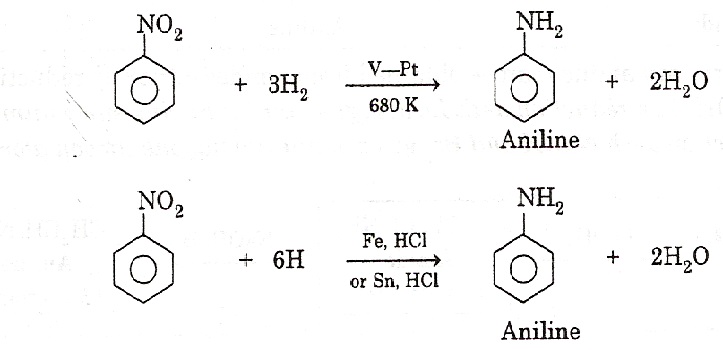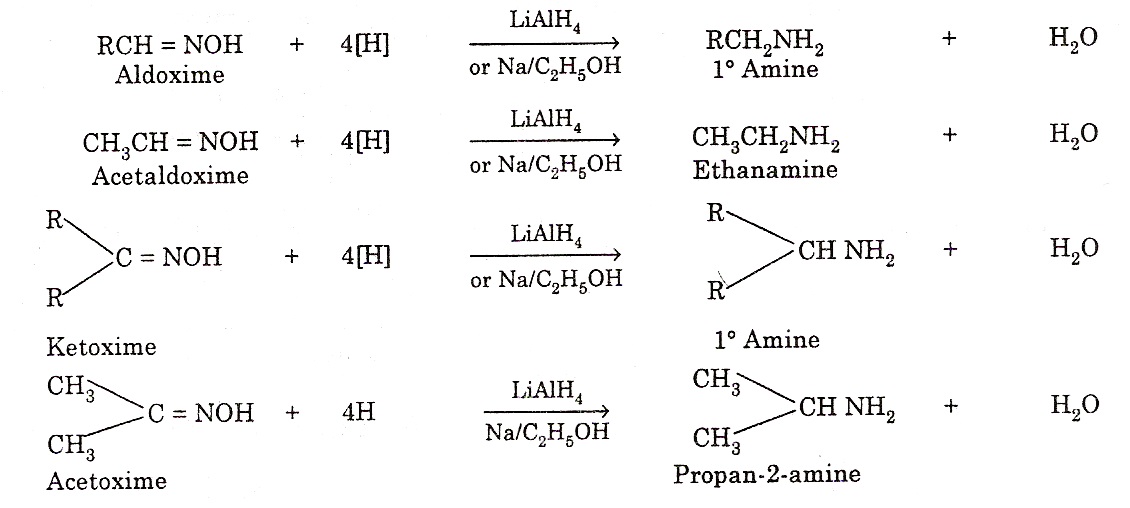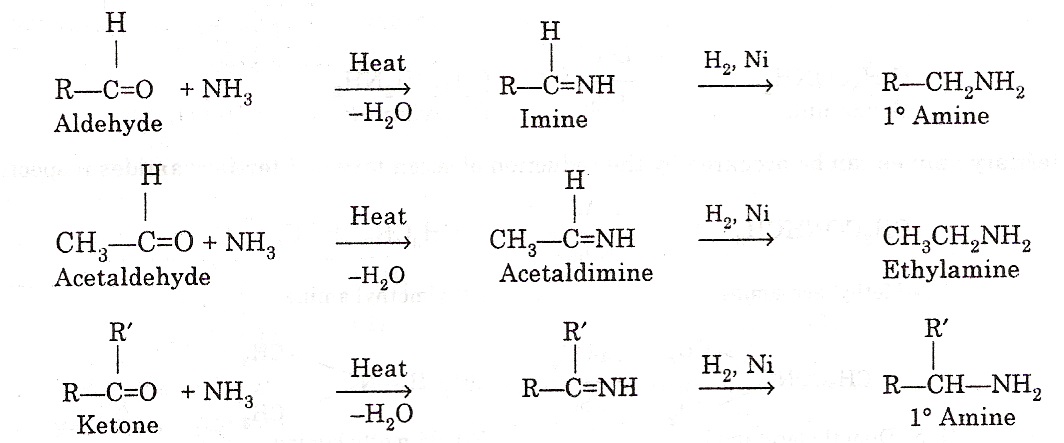Amines are derivatives of ammonia in which one or more hydrogen atoms have been replaced by alkyl group. The amines are classified as primary, secondary or tertiary according to the number of alkyl groups attached to the nitrogen atom. e.g.
R—NH2 R—NH(R) R3—N
Primary amine Secondary amine Tertiary amine
Amines may be classified into two categories, namely—
(i) Aliphatic amines: Amines in which the nitrogen atom is directly bonded to one or more alkyl groups are called aliphatic amines. e.g.
CH3—NH2 CH3—NH—CH3 CH3—N(CH3)—CH3 Methyl amine Dimethyl amine Trimethyl amine
(ii) Aromatic amines: Aromatic amines again classified into two types, as—
(a) Aryl amine in which the nitrogen atom is directly bonded to one or more aromatic ring or aryl groups are called aromatic amines. e.g.

(b) Aryl alkyl amine or side chain substituted amines in which the nitrogen atom is bonded to the side chain of the aromatic ring are called aryl alkyl amines. e.g.
 Structure of amines: Let us consider methylamine (CH3NH2) for illustrating the orbital make up of amines. In methylamine both nitrogen and carbon are sp3 hybridized. One of the sp3 orbital of nitrogen is completely filled and cannot take part in bond formation. The C—N σ-bond in methylamine is formed by overlap of an sp3 orbital of carbon and sp3 orbital nitrogen. Each N—H σ-bond is formed by overlap of an sp3 orbital of carbon and s orbital of hydrogen. Each C—H σ-bond is formed by overlap of an sp3 orbital of carbon and s orbital of hydrogen. All bond angles are approx. 107º.
Structure of amines: Let us consider methylamine (CH3NH2) for illustrating the orbital make up of amines. In methylamine both nitrogen and carbon are sp3 hybridized. One of the sp3 orbital of nitrogen is completely filled and cannot take part in bond formation. The C—N σ-bond in methylamine is formed by overlap of an sp3 orbital of carbon and sp3 orbital nitrogen. Each N—H σ-bond is formed by overlap of an sp3 orbital of carbon and s orbital of hydrogen. Each C—H σ-bond is formed by overlap of an sp3 orbital of carbon and s orbital of hydrogen. All bond angles are approx. 107º.
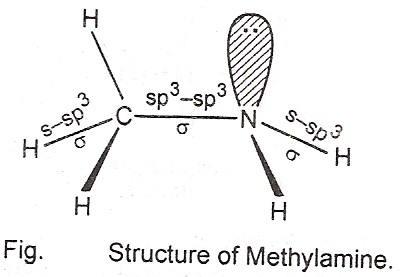
Preparation of amines:
The important methods of preparation of amines are as follows
- Reaction of alkyl halides with ammonia: Amines can be prepared by heating an alkyl halide with alcoholic ammonia in a sealed tube. A mixture of primary, secondary, tertiary amines and quaternary ammonium salt is obtained.
CH3I + H—NH2 ———-> CH3NH2 + HI
Methyl amine
CH3NH2 + ICH3 —————-> (CH3)2NH + HI
Dimethylamine
(CH3)2NH + ICH3 —————-> (CH3)3N + HI
Trimethylamine
(CH3)3N + CH3I —————–> (CH3)4N+I–
Tetramethylammonium iodide
- Reaction of alcohols with ammonia: Amines can be prepared by passing the vapours of alcohol and ammonia over heated alumina at 400ºc. A mixture of primary, secondary and tertiary amines is produced.
CH3OH + H—NH2 ———-> CH3NH2 + H2O
Methyl amine
CH3NH2 + CH3OH —————-> (CH3)2NH + H2O Dimethylamine
(CH3)2NH + CH3OH —————-> (CH3)3N + H2O
Trimethylamine
- Reduction of nitro compound: Aliphatic and aromatic amines can be easily prepared by the reduction of corresponding nitro compounds. The reduction can be carried out in a number of ways—
- (a) Nitro compounds can be catalytically reduced to amine with hydrogen in presence of Raney Ni, Pt, or Pd at room temperature.
R—NO2 + 6H – (Raney Ni, Pt or Pd/Room temperature) –> R—NH2 + 2H2O
Aliphatic amine
Ar—NO2 + 6H —-Raney Ni, Pd, pt room temp–> Ar-NH2 + 2H2O
Aromatic amine
- (b) Nitro compounds can be reduced with active metals such as Fe, Sn, Zn etc. and conc. HCl.

- (c) Nitro compounds can also be reduced to amines with lithium aluminium hydride,LiAlH4
![]()
- Reduction of nitriles (cyanides) and Isonitriles (isocyanides): Nitriles and isonitriles can be reduced to amines in presence of Raney Ni, Pt, or LiAlH4 or Na/C2H5OH.
From cyanides:
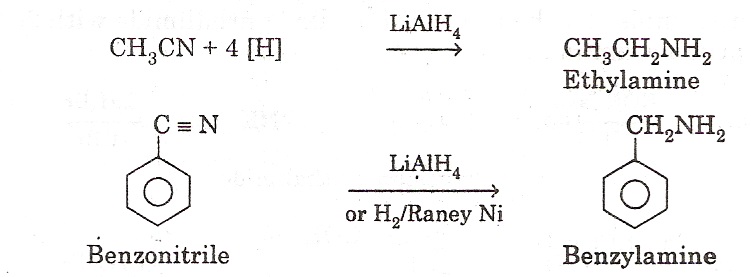
From Isocyanide:

- Reduction of amides: Amides are reduced to the corresponding amines by lithium aluminium hydride or Na/C2H5OH.
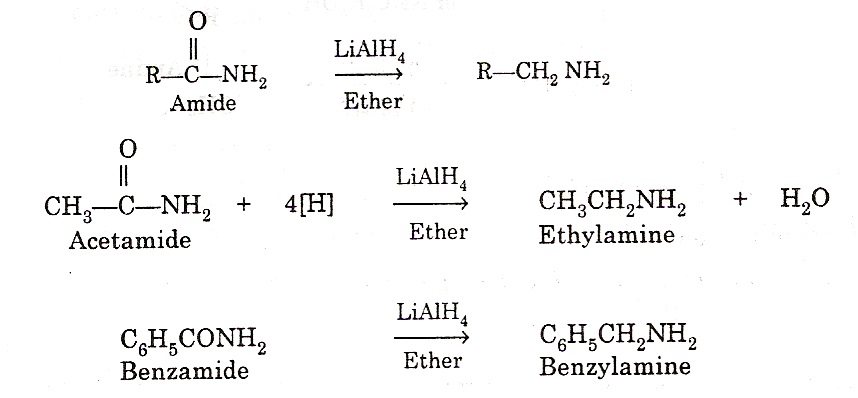
- Hofmann degradation method: Primary amines can be prepared from amides by treatment with Br2 and KOH. The amine formed contains one carbon less than the parent amide. Therefore, this method is used for stepping down the series in organic conversions.

- By reduction of oximes: Primary amines can be prepared by the reduction of oxime of aldehydes and ketones with either LiAlH4 or Na/C2H5OH.

- Reductive amination of aldehydes and ketones: Primary amines may be prepared by reacting aldehyde or ketone with ammonia to form imines which can be reduced with H2, Ni.

- Preparation of aniline: On large scale, aniline is prepared by the reduction of nitrobenzene by catalytic hydrogenation (H2/Pt or V or CuO) or by chemical means using Fe/HCl or Sn/ HCl.
